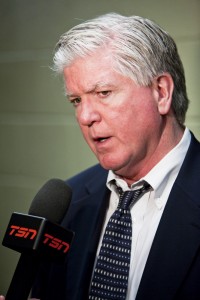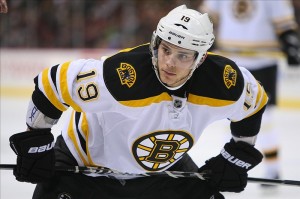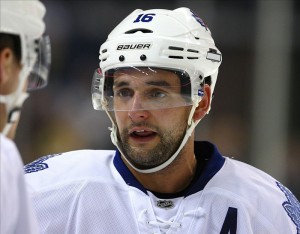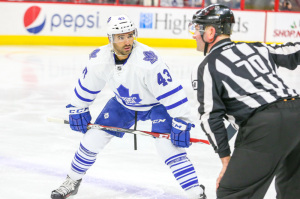
Last week I began the task of reviewing Brian Burke’s term as the General Manager of the Toronto Maple Leafs. I thought, now that it’s been three seasons since he’s been gone, that it would be a good time to go over his work and analyze how he did.
I was a big Burke supporter while he was here – I believed in his vision and I thought that building a team around Phaneuf and Kessel was a great idea. I hoped – even after he was gone – that it would work out. When he was fired, I was shocked – as I think most people were. I thought they didn’t give him enough time and that he’d left the team in a good position and that his genius would be apparent a few years down the line.
I was wrong.
Brian Burke’s time with the Leafs was nothing short of terrifying. You can read Part One here, if you’re so inclined. When we left off, it was the end of the 2009-10 season and the first 17 months of Burke’s reign were seen as a disaster. Today we pick it back up in the summer of 2010 and review the last two and half years of Burke’s term.

Summer 2010
The Leafs had just come off a season in which they finished second-last in the entire league, and had to watch as the Bruins selected Tyler Seguin with their first pick and then Jared Knight with their second. The Leafs did acquire a second-round pick, but used it to select Brad Ross, who hasn’t yet worked out and probably won’t. They also drafted McKegg, Granberg and Carrick, so it wasn’t exactly a great draft – they basically got nothing.
Also worth noting is that the trade with the Blackhawks for Ross cost the Leafs Jimmy Hayes, who is at least an NHL player, and a fairly decent one at that.
That summer, the Leafs made one other trade. They sent Chris DiDomenico, Philippe Paradis and Viktor Stalberg to Chicago for Bill Sweatt and Kris Versteeg. While Versteeg did not succeed in Toronto, he was later parlayed into a good package, so it was a good trade.
As for signings, the Leafs would make two: Clarke MacArthur and Colby Armstrong. While Armstrong proved to be useless, MacArthur was Burke’s best free-agent signing, by a mile. He ended up playing for three seasons and being among the Leafs best players the entire time.

2010-11 Season
Burke began his third season as the Leafs GM in style, winning four straight. Unfortunately, that wouldn’t last and they ended up finishing 37-34-11, good for 10th in the East and eight points out of the Playoffs.
In season, the Leafs made several trades. First they sent Beauchemin to Anaheim in exchange for Joffrey Lupul and Jake Gardiner. Lupul was effective for a while, but the real prize of this trade was Gardiner, a player who is massively underrated, and having a quietly effective season, despite what the Leafs’ least informed fans will try to tell you. This ended up being one of Burke’s best trades.
Another good one was at the trade-deadline, knowing the Leafs were out of it, he sent Versteeg to the Flyers for a first and third-round pick. He also sent Tomas Kaberle to the Bruins for a first, second and Joe Colborne. This trade could have went a long way in balancing out the Kessel trade, but the Burke botched the picks and Nonis idiotically let Colborne go for nothing.
All in all, the third season with Burke at the helm was no better than the first two.
Summer 2011
The summer of 2011 was slightly better than the previous summer, if for no other reason than the Bruins didn’t receive a second lottery pick in the Kessel trade. Still, the Leafs did have to watch them select Dougie Hamilton, currently one of the NHL’s premier young defensemen.
In the first round, the Leafs had two picks. One from the Flyers, who Burke used to select Stuart Percy, a pick that – so far – looks solid. They then had the 30th pick, from Boston for Kaberle, but traded it (along with their second) to the Ducks for the 24rd pick in a trade that today looks horrible.
On the surface, it seems smart to get a higher first-rounder, but considering the picks were just six apart, you probably get better utility from keeping the second and drafting 30th. Burke, however, used the pick to select Tyler Biggs, and while he still may yet turn out, that picks looks bad today, especially when you consider that the Ducks used the 30th pick to select Rickard Rakell (he’s already in the NHL) and then used the 39th pick to take John Gibson, considered one of, if not the very best goalie in the world who isn’t already an NHL starter.
Clearly that trade was disgusting on an Anton Stralman level.
As for the rest of the summer, it was much like the draft: a little good, a little bad. Burke traded a second-round pick to the Avalanche for J.M Liles, which by itself is fine, however, Burke’s tendency to trade his second-round picks is still hurting the Leafs today. Also, Nonis would eventually make the preposterous move of trading Liles for Tim Gleason, and then buying out Gleason’s contract with one of the two compliance buy-outs.
A better move was trading Brett Lebda and Robert Slaney to the Predators for Cody Franson and Mathew Lombardi. Unfortunately, the Leafs would embark on a series of petty contract negotiations with Franson that would eventually force them to trade him, rather than pay market price when he was a UFA. The Leafs definitely need to take a lesson here and realize that it’s always better to bet on your own guys and sign them long-term instead of having to pay market price for your own players, which almost always results in bad contracts.
As far as Free Agency goes, in the Summer of 2011 Burke signed two: Philippe Dupuis and Tim Connolly. Both were disasters. Dupuis suited up for just 30 games for the Leafs, scoring no goals, and Connolly……well we wish Connolly had only played 30 games.

2011-12 Season
In what would be the Leafs final season with Burke at the helm, the team started off strong. Everything was going great until the famous “18 Wheeler off the Cliff” collapse that lead to the firing of Ron Wilson. As if it wasn’t bad enough that the Leafs would again miss the Playoffs, Burke continued his war against progressive hockey by going old-school in his coaching choice. Despite Carlyle’s history of being unable to coach teams to strong possession numbers, and the Leafs constant poor possession numbers under Wilson, Burke did not see a connection and he gave the job to his old friend.
Many thought the supposedly defensive-oriented Carlyle and Burke would be a match made in heaven – both men wanted to play old-school defense-first, hard hitting hockey. Unfortunately, the NHL today is passed on speed and and puck movement, and the Leafs never iced a lineup capable of such things anyways. All that happened was that they were – save one lucky Playoff appearance in a shortened season – just as bad (if not worse) under Carlyle than they were under Wilson.
The Leafs ended the season 13th in the East and missed the Playoffs again. They made no in-season transactions of note. If I have one very positive thing to say about Brian Burke, it’s that he resisted the urge to sell his soul for the Playoffs in this season. He easily could have traded the Leafs first rounder and/or Nazem Kadri in order to make the Playoffs, but even though it would make him look better in the short-term, he did no such thing and stood pat at the deadline.
Summer 2012
The Summer of 2012 was probably Burke’s finest moment as Leafs GM – at the draft he selected Morgan Rielly fifth overall (and also added Matt Finn, Connor Brown and Viktor Loov) and then traded Luke Schenn to Philadelphia for James Van Riemsdyk in what would be his final transaction for the Leafs.
The NHL owners ended up locking out the players and the season never began until the end of January. The Leafs shocked the hockey world when, just after it was announced that the lockout had ended, they fired Brian Burke.
Like I said, at the time I thought this was a mistake. I no longer think so.

Final Analysis
In the end, Brian Burke’s time with the Leafs can be categorized as a total failure. Like it or not, this rests almost entirely on the Phil kessel trade, which could not have possibly worked out worse for the Leafs. Burke made a couple of good trades (Gardiner/Lupul, Phaneuf, JVR and Franson) but also some very bad ones (Kessel, Stralman, almost anything involving draft picks). His free agents signing, outside of MacArthur, were brutal. He had a tendency to trade second-round picks, picking just once in four drafts with his own pick. Overall, his draft record, when he picked, is good, but can’t really be judged until players like Loov, Nilsson, Brown and Leivo become known qualities.
Also, the number of players he basically gave away that would have been beneficial to the Leafs today include (but is not limited to): Anton Stralman, Brandon Saad, Jimmy Hayes and John Gibson.
Burke’s five year contract limit was silly and detrimental; had he signed Kessel to a ten year deal, instead of a five year deal, the Leafs would be in a better position today; had he been willing to go longer term, the Sedin twins may have been skating for the Leafs for the last half-decade.
Overall, his drafting was good, but he traded too many picks; his trading was good, but he made some bad ones; his FA signing and the contracts handed out to his own players were bad. His record with the Leafs was 129-135-42 over four full years and change. This looks much better than reality, because the NHL treats losses in O.T like ties, in reality, Burke’s Leafs lost 48 more times than they won.
What it really comes down to is that Burke never got the Leafs a top-line centre (which, if the rest of his vision was in sync, would have been fine because he drafted one in Nazem Kadri) or a top-line defenseman. You simply cannot win in the NHL without these two key positions, and Burke’s failure is tied to his inability to acquire them, and, ironically, the fact that he traded both for a winger who’s best years will be behind him by the time the team is actually competitive.
To recap:
2008-09: Missed Playoffs, drafted Kadri
2009-10: Missed Playoffs, Boston drafted Seguin
2010-11: Missed Playoffs, Boston drafted Hamilton
2011-12: Missed Playoffs, drafted Morgan Rielly
When it’s all said and done, I don’t think there’s even any real debate: Burke’s time with the Leafs was a complete and abject failure. In fact, it is so bad that had he been trying to fail on purpose, it couldn’t have gone much worse.
Thanks for reading.